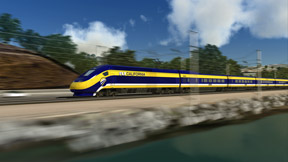In the letter, he urged the Metropolitan Transportation Commission, which coordinates transit planning in the Bay Area, to take the lead in coming up with some sort of compromise rail plan that might be acceptable to the project’s many critics.
“Our inability, as a region, to articulate a clear vision for high-speed rail has real consequences,” Wunderman wrote to commission Chairwoman Adrienne Tissier, who also is a San Mateo County supervisor. “We weaken our support in the state and federal government, we put ourselves at the back of the funding line, and we strengthen those who argue that high-speed rail is an impossible fantasy.”
As California Watch has reported, Peninsula opponents have filed two environmental lawsuits against the California High-Speed Rail Authority. Opponents fear that running the bullet train the length of the Peninsula will bring blight and sprawl – especially if the trains run on elevated tracks for most of the way as currently planned. But the legal dispute over the project’s environmental planning has morphed into a more generalized critique of the entire financial plan for building and operating the bullet train.
Recently, a compromise was proposed by three Peninsula lawmakers: Democratic California Congresswoman Anna Eshoo; state Sen. Joe Simitian, D-Palo Alto; and Assemblyman Rich Gordon, D-Los Altos.
They suggested confining high-speed rail to the present right of way of the Caltrain commuter rail service and scrapping plans for elevated tracks. This would create a “blended system that integrates high-speed rail with a 21st Century Caltrain,” they wrote.
Some boosters countered that without its own tracks, the bullet train never would be able to run frequently enough to meet passenger demand – and generate revenues sufficient to head off crippling operating deficits. Wunderman, though, wrote that the lawmakers’ ideas could represent “a promising path forward.”
Some rail experts say that saving the project will require a drastic systemwide overhaul.
Michael Setty, a transportation consultant and proprietor of the publictransit.us transportation blog, has proposed a high-speed rail “reboot” [PDF] that he says would be far cheaper than the current plan.
His stripped-down version of high-speed rail would use “existing, mostly under-utilized rail lines” whenever possible, thus saving the tremendous cost of constructing new tracks for the bullet train.
To link Northern and Southern California, he would run the main spur “down the middle of I-5” on the western side of the Central Valley.
Using the freeway corridor, rather than the rich agricultural land to the east, “eliminates 99 percent of the opposition” that the project has encountered from Central Valley farmers, he said in an interview. It also would dramatically reduce land acquisition costs.
The link between Los Angeles and Bakersfield would run over Grapevine, also to save money; the expensive, controversial jog into the Antelope Valley would be eliminated as well. And he would link the Bay Area with the Central Valley via the I-580 corridor over Altamont Pass, mostly so that prospective passengers from the East Bay and North Bay could be better served.
Stripping the project down to a 400-mile, $20 billion system might well attract the billions in private investment capital needed to build it, he said.
“The project is in a lot of trouble,” he said, “but there are ways to salvage it."
Lance Williams is an investigative reporter for California Watch, a project of the non-profit Center for Investigative Reporting. Find more California Watch reporting here.
